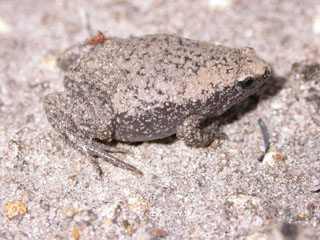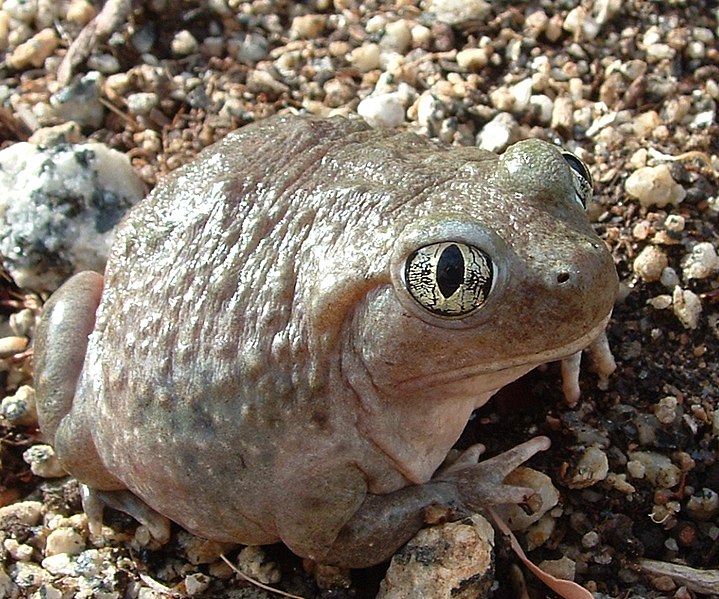There are the flat, pointy-nosed type, frequently the front-limb diggers. These include:
Rhinophrynus dorsalis - the Mexican Burrowing Toad, only member of the family Rhinophrynidae (see awesome photo here)
Hemisotidae - 9 species in the genus Hemisus from Africa (photo)
Nasikabatrachus sahyadrensis - a recently discovered purple frog from India, only member of the family Nasikabatrachidae

Microhylidae - many species in many genera found worldwide, including the North American Gastrophryne and others

Then there are the fat round ones (okay, so Rhinophrynus and the ugly purple one kind of bridge this artificial class system). They are characterized by a short, squat body, big bug eyes on the top of the head, hard digging spades on the limbs, and an episodic lifestyle of spending most of the year buried underground in aestivation, only coming up during rains to breed. These include:
Microhylidae - another member of this large family is the genus Breviceps from Africa (split into the Brevicipitidae in some taxonomies). These frogs are some of the most hilarious looking of all amphibians. I can't help but laugh everytime I see one. You MUST see photos here, here, here, here, here, and here.
To see these frogs in action, check out this clip from Life in Cold Blood:
Myobatrachidae - this diverse family takes up many convergent niches in Australia, including burrowers in the genera Neobatrachus, Opisthodon, Notaden, and more.


For Notaden - another MUST see photo can be found in this fieldherping thread. I guarantee you will burst out laughing on seeing it - look at that frowny face!
Notaden are referred to as 'spadefoots' for their digging apparatus, as are some species well known in North America and Europe:
Scaphiopodidae, seven species in two genera (Scaphiopus and Spea) in North America


Pelobatidae, four species in the genus Pelobates

These last two families are closely related and probably don't truly represent convergence.
Finally, I discovered during my stay in Venezuela that some members of the diverse Neotropical family Leptodactylidae deserve to be labeled spadefoots (spadefeet?) - particularly the 12 species of Pleurodema.
Pleurodema brachyops

Pleurodema brachyops inhabit Hato Masaguaral, where I saw them on several different nights after rain. Like so many of the other species listed above, Pleurodema is a burrower that lives in the loose sandy soils of the llanos. They emerge after rains to breed in the pools that form during the wet season, then disappear underground again. While I never personally saw emergence, the description of this behavior in Staton and Dixon (1977) is perfect:
This ubiquitous frog was invariably seen on sandy soil and apparently stayed beneath the soil throughout the day. This species was observed emerging from sandy substrates between 2300-2330 hrs on several nights. Their emergence from a sandy substrate with sparse vegetation between the above hours reminds one of "popping popcorn". Almost simultaneously, several will emerge by a sudden eruption of sand, head & eyes appear first, followed almost immediately by a short jump which clears them from their daytime retreat. They appear as lumps of damp sand with only the eyes visible, but shortly the condensation on surrounding grass leaves washes away the sand particles leaving the frog almost the same color as the sand. The only visible color to the eye is the bright orange "flash marks" of the groin as they jump from place to place. Calling and breeding began immediately after the first heavy rain of the wet season and extended throughout the rainy season. It called from shallow water.
Unfortunately, this Pleurodema chose to emerge in a less-than-glamorous location all too common on a working cattle ranch:

The orange flash marks mentioned by Staton and Dixon actually form big bright eyespots when the frogs are floating in the puddles, calling. Also check out the mosquitos feeding on the floating frog (click to zoom).


Here you can make out two hardened digging spades on the rear foot:

Finally, I leave you with Pleurodema love. To hear their calls, see my frog calls video.



Reference
Staton MA, Dixon JR (1977) The herpetofauna of the central llanos of Venezuela: noteworthy records, a tentative checklist, and ecological notes. Journal of Herpetology 11(1):17-24.
So, actually, the recent molecular work places the Purple Frog (Nasikabatrachus sahyadrensis), in the family Sooglossidae, the Seychelles endemic family. Neat stuff.
ReplyDelete